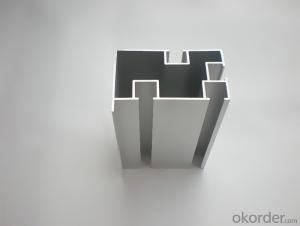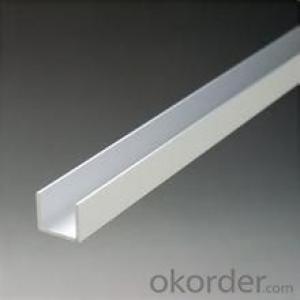Customized Aluminum Extrusion Profiles - Aluminum 6063 T6 Extrusion
- Loading Port:
- China Main Port
- Payment Terms:
- TT OR LC
- Min Order Qty:
- -
- Supply Capability:
- -
OKorder Service Pledge
OKorder Financial Service
You Might Also Like
Aluminium is a relatively soft,durable, lightweight, ductile and malleablemetal with appearance ranging from silvery to dull gray,depending on the surface roughness. It is nonmagnetic and does not easilyignite. A fresh film of aluminium serves as a good reflector (approximately92%) of visible light and an excellent reflector (as much as98%) of medium and far infrared radiation. The yield strength of pure aluminium is 7–11 MPa,while aluminium alloys have yield strengths ranging from200 MPa to 600 MPa. Aluminium has about one-third the density and stiffnessof steel. It iseasily machined,cast, drawn and extruded.
Aluminum Profile
Material | Alloy 6063,6061,6005or according to customer’s choice |
Temper | T3, T4, T5, T6 |
Surface | Anodize, electrophoresis, powder coating, PVDF coating, wood grain painting, matted, etc. |
Length | Coating 6.5 meters, Anodizing 6.5 meters, Mill finish 5 meters |
Application | Industrial, electrical equipment(TV set, air conditioner, refrigerator, computer), decoration,construction, transportation |
Custom Made | We can package following with customer's request. |



- Q: This question asks if aluminum profiles can be utilized in cold weather conditions and seeks an explanation for their suitability.
- <p>Yes, aluminum profiles can be used in cold climates. Aluminum is a lightweight and durable material that maintains its strength and structural integrity even in extreme low temperatures. It does not rust or corrode, which makes it ideal for use in environments with harsh weather conditions. Additionally, aluminum has good thermal conductivity, which allows it to dissipate heat effectively, but it also has low thermal expansion, meaning it does not expand or contract significantly with temperature changes. This characteristic helps prevent warping or cracking in cold climates. Properly designed and installed aluminum profiles can withstand the challenges of cold weather without compromising their performance or longevity.</p>
- Q: Can aluminum profiles be used in the construction of data centers?
- Yes, aluminum profiles can be used in the construction of data centers. Aluminum profiles are lightweight, durable, and have excellent thermal conductivity, making them suitable for constructing data center enclosures and racks. They can provide structural support, facilitate cable management, and offer efficient heat dissipation, which is crucial for maintaining optimal operating conditions in data centers. Additionally, aluminum profiles can be easily customized and assembled, allowing for flexible and scalable designs to accommodate the ever-evolving needs of data centers.
- Q: How do aluminum profiles contribute to LEED certification?
- LEED certification can be achieved through various means with the use of aluminum profiles. Firstly, aluminum is a sustainable material that can be easily recycled without compromising its quality. Incorporating aluminum profiles in construction projects helps reduce the demand for new raw materials, conserves energy, and minimizes greenhouse gas emissions. This aligns with LEED's objective of minimizing the environmental impact of buildings. Furthermore, aluminum profiles possess the qualities of being lightweight and durable, making transportation and installation efficient. This aspect contributes to earning LEED points in the Sustainable Sites category, which emphasizes the use of materials and techniques that have minimal impact on ecosystems and reduce pollution during construction. Moreover, aluminum profiles can enhance energy efficiency in buildings. By incorporating features like thermal breaks and insulation, aluminum profiles prevent heat transfer and reduce energy consumption for heating or cooling. This aspect contributes to earning LEED points in the Energy and Atmosphere category, which advocates for the use of energy-efficient systems and materials. Additionally, aluminum profiles are corrosion-resistant and require minimal maintenance throughout their lifespan. This durability contributes to earning LEED points in the Materials and Resources category, which encourages the use of long-lasting, low-maintenance materials to minimize waste and the need for replacement. In conclusion, aluminum profiles play a vital role in achieving LEED certification as they promote sustainability, reduce environmental impacts, improve energy efficiency, and enhance building durability. By considering the incorporation of aluminum profiles in construction projects, architects and builders can earn LEED credits and contribute to a more sustainable future.
- Q: What are the different surface patterns available for aluminum profiles?
- There are several different surface patterns available for aluminum profiles, each offering unique aesthetic and functional benefits. Some of the most commonly used surface patterns include: 1. Smooth: This is the most basic surface pattern, with a smooth and polished finish. It provides a sleek and modern appearance, making it ideal for applications where aesthetics are important. 2. Brushed: This surface pattern is characterized by fine lines or brush strokes running in a single direction. It creates a textured and satin-like appearance, which is often chosen for its contemporary and industrial appeal. 3. Anodized: Anodizing is an electrochemical process that creates a durable and corrosion-resistant surface on aluminum profiles. It can be customized to produce various colors and finishes, such as matte, glossy, or metallic. 4. Powder-coated: Powder coating involves applying a dry powder onto the aluminum surface and then heating it to create a smooth and durable finish. This process allows for a wide range of colors and textures, including matte, glossy, and textured finishes. 5. Wood grain: By using a specialized printing process, aluminum profiles can be made to mimic the appearance of wood. This surface pattern offers the natural and warm look of wood, while providing the benefits of aluminum, such as durability and low maintenance. 6. Textured: Aluminum profiles can also be given a textured surface pattern, which can range from a fine sand-like texture to a more pronounced embossed or hammered look. Textured surfaces not only enhance the visual appeal but also provide better grip and slip resistance. These are just a few examples of the many surface patterns available for aluminum profiles. The choice of surface pattern depends on the specific application requirements, desired aesthetics, and functional needs.
- Q: Are aluminum profiles suitable for use in exterior wall insulation systems for residential buildings?
- <p>Yes, aluminum profiles can be used for exterior wall insulation systems in residential buildings. They are known for their durability, corrosion resistance, and low thermal conductivity, which makes them ideal for creating thermal barriers. Aluminum profiles can support the structure of the insulation system, providing a stable framework while also contributing to energy efficiency by reducing heat transfer. However, it's important to ensure that the profiles are properly sealed and insulated to prevent thermal bridging and to maintain the overall insulation performance of the building envelope.</p>
- Q: 3030 aluminum profiles, can be used in outdoor snow exposure environment?
- This refers to the 3030 heavy aluminum profiles. General aluminum profile manufacturers will make a number of their own products,
- Q: Are aluminum profiles suitable for decorative applications?
- Indeed, decorative applications can benefit greatly from the use of aluminum profiles. This material, known for its versatility, provides numerous advantages in decorative contexts. To start with, aluminum profiles can be easily shaped and molded into various designs, offering endless possibilities for decorative applications. Designers have the freedom to extrude them into different shapes, sizes, and patterns, allowing for the creation of unique and visually pleasing decorative elements. Furthermore, aluminum profiles exhibit excellent durability and resistance to corrosion, making them suitable for both indoor and outdoor decorative applications. Thanks to their rust and weather resistance, decorative elements made from aluminum profiles can maintain their appearance for an extended period. Moreover, aluminum profiles can be finished in different ways to enhance their decorative appeal. Anodizing or powder-coating can be applied to the surface, adding color, texture, and protection. These finishing options allow for customization and the ability to harmonize the profiles with the overall design scheme. Additionally, aluminum profiles possess the advantageous combination of being lightweight and strong, facilitating their installation and handling during the decorative application process. This characteristic is especially valuable in situations where weight is a consideration, such as with suspended or wall-mounted decorative elements. Finally, it is worth noting that aluminum is an environmentally friendly and sustainable material. It is entirely recyclable, and the production process of aluminum profiles requires significantly less energy compared to other materials. By choosing aluminum profiles for decorative applications, one aligns with sustainable design principles and contributes to reducing the environmental impact. In conclusion, the versatility, durability, corrosion resistance, customization options, lightweight nature, and sustainability of aluminum profiles make them highly suitable for decorative applications. Whether it is for interior or exterior decorative elements, aluminum profiles offer a wide range of possibilities to enhance the aesthetic appeal of any space.
- Q: Are aluminum profiles suitable for architectural design that demands a distinctive visual appeal?
- <p>Yes, aluminum profiles can be effectively utilized in architectural design to achieve a unique aesthetic look. They offer versatility in terms of shape and size, allowing for the creation of distinctive designs. Their lightweight nature and high strength make them ideal for various architectural applications. Additionally, aluminum profiles can be easily finished or coated to match specific design requirements, enhancing their visual appeal. Their durability and resistance to corrosion also make them a sustainable choice for long-lasting architectural projects.</p>
- Q: Explain if aluminum profiles can be utilized in constructing energy-efficient building systems and if so, how they contribute to energy efficiency.
- <p>Yes, aluminum profiles can be used to create energy-efficient building systems. They are lightweight yet strong, which reduces the energy required for construction. Aluminum profiles also have excellent thermal conductivity, allowing them to be used in double-glazed windows and doors, improving insulation and reducing heat loss. Additionally, aluminum can be easily recycled, reducing the energy needed for new materials. Their high reflectivity can also help in reducing heat absorption, further contributing to energy efficiency.</p>
- Q: Are aluminum profiles suitable for balcony railings?
- Indeed, balcony railings can be effectively made using aluminum profiles. Aluminum is a favored material for balcony railings because it possesses qualities such as resilience, robustness, and minimal upkeep requirements. Its resistance to rust and corrosion makes it exceedingly appropriate for outdoor applications. Moreover, aluminum profiles can be effortlessly tailored and molded to match any desired design or architectural style. Although lightweight, they offer ample strength to ensure necessary support and safety for balcony railings. Additionally, aluminum railings are obtainable in a plethora of finishes and colors, providing limitless possibilities for design. On the whole, aluminum profiles are a dependable and fashionable choice for balcony railings.
Send your message to us
Customized Aluminum Extrusion Profiles - Aluminum 6063 T6 Extrusion
- Loading Port:
- China Main Port
- Payment Terms:
- TT OR LC
- Min Order Qty:
- -
- Supply Capability:
- -
OKorder Service Pledge
OKorder Financial Service
Similar products
Hot products
Hot Searches
Related keywords


























